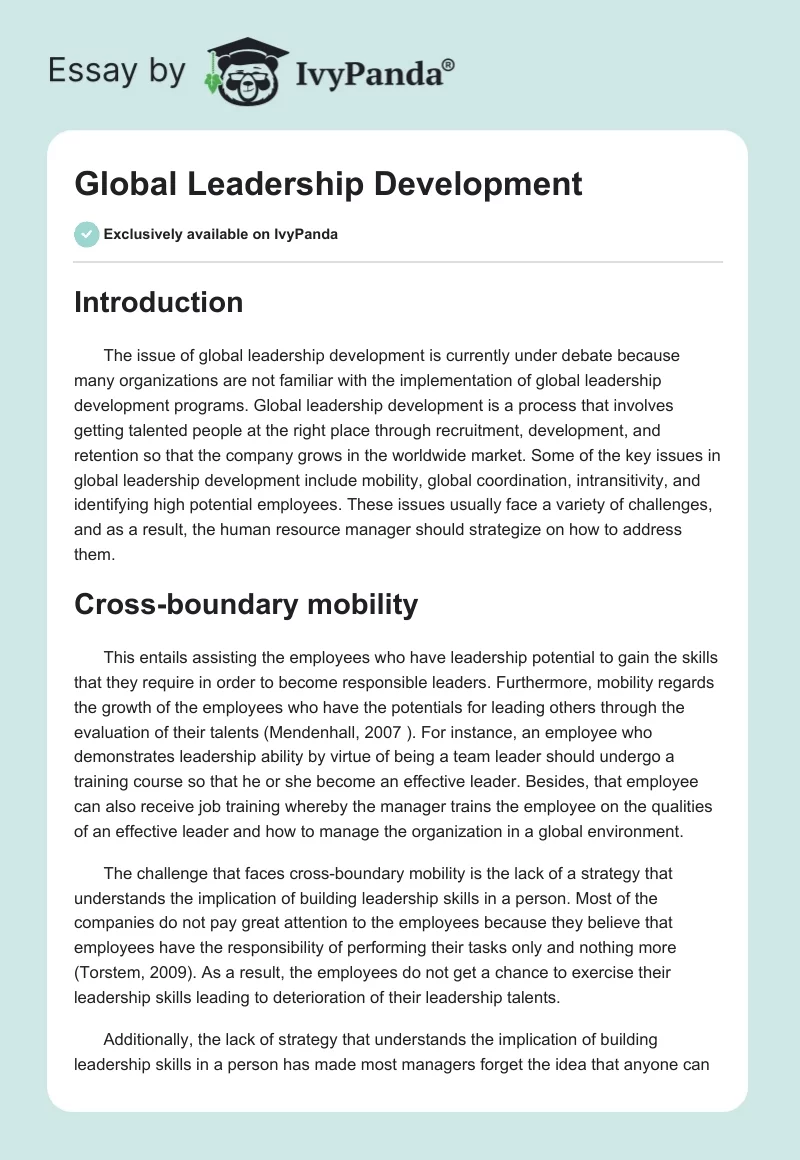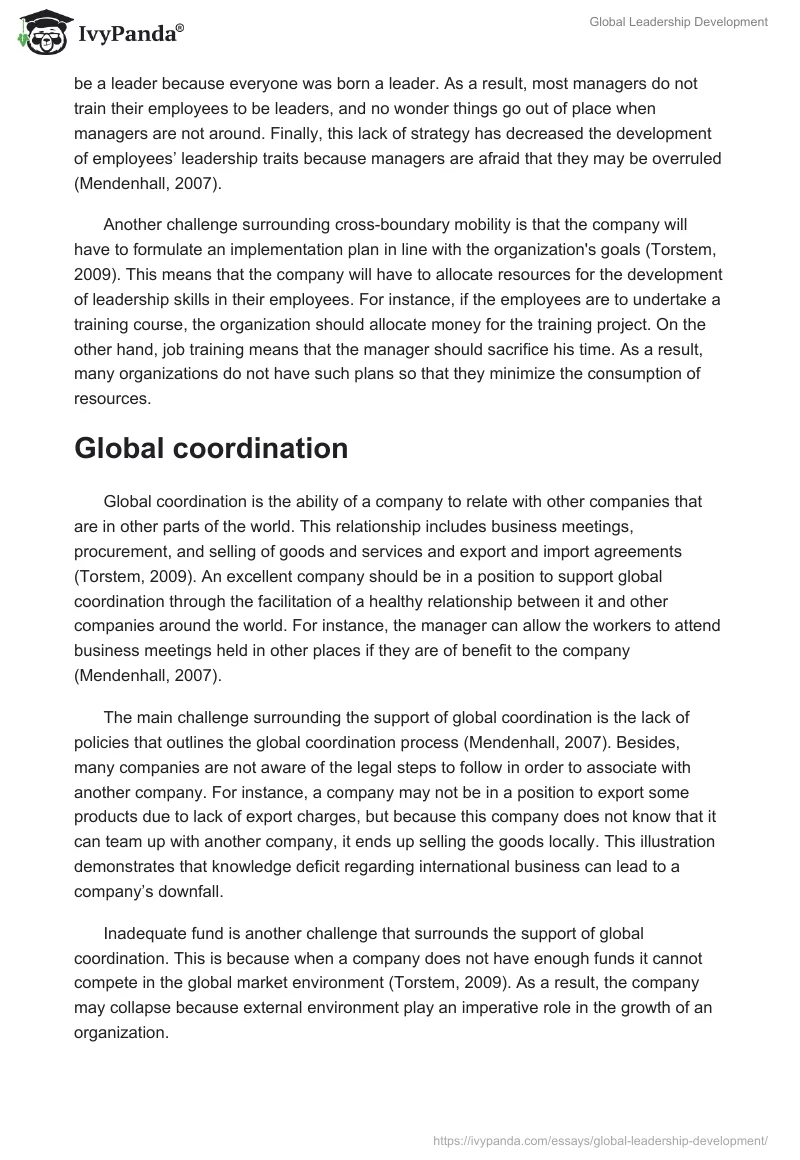Introduction
The issue of global leadership development is currently under debate because many organizations are not familiar with the implementation of global leadership development programs. Global leadership development is a process that involves getting talented people at the right place through recruitment, development, and retention so that the company grows in the worldwide market. Some of the key issues in global leadership development include mobility, global coordination, intransitivity, and identifying high potential employees. These issues usually face a variety of challenges, and as a result, the human resource manager should strategize on how to address them.
Cross-boundary mobility
This entails assisting the employees who have leadership potential to gain the skills that they require in order to become responsible leaders. Furthermore, mobility regards the growth of the employees who have the potentials for leading others through the evaluation of their talents (Mendenhall, 2007 ). For instance, an employee who demonstrates leadership ability by virtue of being a team leader should undergo a training course so that he or she become an effective leader. Besides, that employee can also receive job training whereby the manager trains the employee on the qualities of an effective leader and how to manage the organization in a global environment.
The challenge that faces cross-boundary mobility is the lack of a strategy that understands the implication of building leadership skills in a person. Most of the companies do not pay great attention to the employees because they believe that employees have the responsibility of performing their tasks only and nothing more (Torstem, 2009). As a result, the employees do not get a chance to exercise their leadership skills leading to deterioration of their leadership talents.
Additionally, the lack of strategy that understands the implication of building leadership skills in a person has made most managers forget the idea that anyone can be a leader because everyone was born a leader. As a result, most managers do not train their employees to be leaders, and no wonder things go out of place when managers are not around. Finally, this lack of strategy has decreased the development of employees’ leadership traits because managers are afraid that they may be overruled (Mendenhall, 2007).
Another challenge surrounding cross-boundary mobility is that the company will have to formulate an implementation plan in line with the organization’s goals (Torstem, 2009). This means that the company will have to allocate resources for the development of leadership skills in their employees. For instance, if the employees are to undertake a training course, the organization should allocate money for the training project. On the other hand, job training means that the manager should sacrifice his time. As a result, many organizations do not have such plans so that they minimize the consumption of resources.
Global coordination
Global coordination is the ability of a company to relate with other companies that are in other parts of the world. This relationship includes business meetings, procurement, and selling of goods and services and export and import agreements (Torstem, 2009). An excellent company should be in a position to support global coordination through the facilitation of a healthy relationship between it and other companies around the world. For instance, the manager can allow the workers to attend business meetings held in other places if they are of benefit to the company (Mendenhall, 2007).
The main challenge surrounding the support of global coordination is the lack of policies that outlines the global coordination process (Mendenhall, 2007). Besides, many companies are not aware of the legal steps to follow in order to associate with another company. For instance, a company may not be in a position to export some products due to lack of export charges, but because this company does not know that it can team up with another company, it ends up selling the goods locally. This illustration demonstrates that knowledge deficit regarding international business can lead to a company’s downfall.
Inadequate fund is another challenge that surrounds the support of global coordination. This is because when a company does not have enough funds it cannot compete in the global market environment (Torstem, 2009). As a result, the company may collapse because external environment play an imperative role in the growth of an organization.
Intransitivity
Intransitivity involves the competencies and the attitude of shifting from a lower level to a higher level where skills of a person does not match with that level (Mendenhall, 2007). The match does not exist because both skills and attitude of the higher level are different from the one at the previous level. Therefore, the employee needs to acquire knowledge and skills in order to function efficiently and effectively.
The challenge surrounding intransitivity is the ability of the organization to both deal and adapt to competition of the confronting situation. This is because the employee needs to mould his or her personality so that he or she can comfortably fit into the new situation (Mendenhall, 2007). For instance, an employee who used to reporting to work late and leaving before time may need to change that behavior once he receive promotion to a higher level. This can be difficult because the employee has already formed that habit but with acquired skills and knowledge, it is possible for the employee to transform into a disciplined individual.
Identifying high potential employees
Identification of employees with talents to fill the leadership position has always faced a variety of challenges. To begin with, many leaders complain that the identification of a talented leader delays the organization plan and international expansion. This is because majority of the companies have trouble in identifying a talented manager overseas (Mendenhall, 2007). For example, in an Asian company the manager took approximately nine months to identify a potential leader.
Additionally, the process of identifying potential leaders requires disciple and efforts. This is because one needs to review and analyze imperative information about that person, make a sound decision about his readiness to work as leader and then provide support and development opportunities to him (Torstem, 2009). This process is tiresome and time consuming and as a result, identification of a potential employee becomes difficult.
Strategies addressing the above issues
Due to the challenges facing the issues in global leadership development, the International Human Resource Management (IHRM) has developed strategies and practices that address those issues. They include, developing the managers experience, career development, emphasizing on the need of the managers to develop a culture of carrying out international market studies and policies development (Torstem, 2009).
The development of the manager’s experience helps in enhancing the capability of the manager globally (Mendenhall, 2007). As a result, the manager will be able to identify potential employees with ease. This is because the manager will be familiar with the different context of the business internationally. This familiarity will ease the process of identifying talented leaders because the manager will always know whom he wants and where to find him.
On the other hand, career development involves educating people about new skills. Besides, it involves informing the employees about current issues that affect the organization (Torstem, 2009). Therefore, career development addresses the issue of intransitivity by helping the employees who have moved to a new level acquire the necessary skills. For instance, through career development, an employee can know what is required of him and the way to accomplish it.
Additionally, emphasis on market research addresses the issue of global coordination. This is because by studying the business environment, the manager will know which activities to undertake. Additionally, information about business conferences and export and import strategies are acquired through market research (Mendenhall, 2007). For instance, market study can help the manager know which organizations he can benefit from.
Finally, policy development will address the issue of cross boundary mobility. This involves the development of policy that allows the managers to train employees about leadership and giving them a chance to exercise their leadership talents. On the other hand, policy development can also address the issue of global coordination. This is through formulation of policies that facilitate collaboration between different organizations.
Conclusion
In conclusion, global leadership development is a significant aspect for the growth of any organization. This is because it creates employees who are responsible and accountable to the organization and its customers. Therefore, every organization should strive to facilitate global leadership development.
References
Mendenhall, M. (2007). Global Leadership: Research, Practice and Development. New Jersy: Fransis and Taylor. Web.
Torstem, D. (2009). Developing Global Business Leaders: Policies, Processes and Innovations. New York: Greenwood publishing group. Web.


